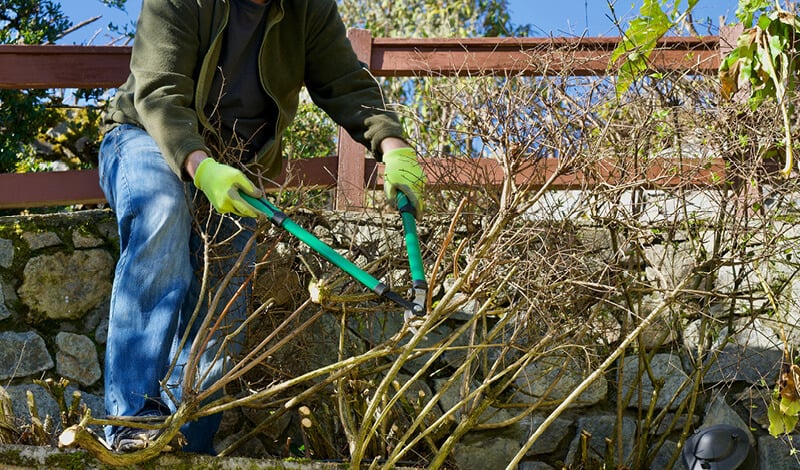

Spring Yard Cleanup Checklist
Stay on top of spring yard cleanup with a checklist to help you prioritize projects.
Spring yard cleanup involves removing debris and winter damage from your yard and preparing it for the new growing season. It's a great time to tidy up your lawn, gardens, and outdoor spaces, and make any necessary repairs or renovations. A well-maintained yard will not only enhance the aesthetic of your home but is also a vital part of home maintenance and an excellent way to get a head start on the gardening season. Let’s get busy.
First Things First
Get Started: While March is typically a good month to start yard cleanup, the best time to begin the work depends on the conditions and temperature. You're good to go when all snow and ice have completely melted from the yard, and warmer temperatures have moved in.
Inspect: Walk your property, inspecting the lawn, garden, and outdoor areas. Focus on standard tasks such as trimming overgrown bushes and shrubs, cleaning patio furniture, pruning trees, taking down holiday decorations, removing dead stems and roots from potted plants, cleaning gutters and downspouts, detangling dead vines from trellises, raking leaves, picking up pinecones, and clearing pine needle piles.
Establish a Timeline: Prioritize your projects based on your inspection results. For instance, wait to rake the lawn until after trimming shrubs and unclogging gutters, so you can efficiently remove twigs, gutter debris, and leaves in one go.
Shrubs
Prune and Trim: Good pruning stimulates new growth, helps to prevent disease, and shapes the shrubs like a good haircut. If shrubs have early blooms, wait to prune until all the buds have flowered to avoid the accidental cutting of buds.
Garden & Flower Beds
Clean Beds: Rake debris, leaves, and winter mulch out of the beds and discard or compost. Pull weeds and debris from all beds, dead vegetables from the garden, and dead annuals and perennial growth from the flower beds.
Edge: Without intervention, grass naturally grows from the lawn into the garden and flower beds. Use an edger to cut a crisp line between the lawn and the beds. Not only does the tidy delineation look better, but it also helps to contain mulch in the beds.
Mulch: Mulch is beneficial to soil health by helping to retain moisture, protect plants from exposure to erosion and temperature swings, and nurture the soil biology below. The best time to mulch is early to mid-spring. Rake the beds clear of existing mulch and replace it with an even 2 inches of fresh mulch.
Fertilize: Fertilizer ensures that soil nutrients are at a level to promote healthy growth. When you have chosen the processed or organic type and amount of fertilizer you want to use in your garden soil, mix the fertilizer 3 to 5 inches before planting; then water. For flowering plants, fertilize a week after your last frost before any growth begins.
Perennial Division: If you didn’t divide perennials in the fall, now is the time to distribute them to other beds. Dividing young perennials as they emerge in the spring provides them several weeks to get established before warm weather sets in.
Plant: When you have cleaned the beds and treated the soil, it’s time to plant your garden and flower beds.
Lawn
Clean: Spring is the perfect time for deep cleaning your lawn. Start by picking up tree branches and raking up any leaves and debris accumulated over the winter months. Raking will help improve airflow and promote healthy growth. Removing the debris will also help reduce the risk of disease and insect infestations.
Aerate: Aeration is the process of either removing small plugs of soil from the lawn or poking holes into it to allow for better water, air, and nutrient penetration. This is especially important for lawns that have become compacted over time. Aerating in the spring can help reduce water runoff, improve root growth, and enhance the overall health of your lawn. Core aeration is the process of punching out cores, or plugs of soil. The types of core aerators are manual, gas-powered, and tow-behind. Spike aeration pokes holes in the soil using pitchforks, spiked shoes, or rolling push and tow-behind aerators. In preparation for aeration, mow the lawn and water it a few days before aeration. Doing so helps the chore of aeration by exposing the surface, moistening the soil, and providing easy access to the ground.
Dethatch: Thatch is a layer of dead grass and other organic material that accumulates on the soil’s surface. If it builds up too much, it can prevent water, air, and nutrients from reaching the roots of your grass. Dethatching in the spring will help improve the health of your lawn and promote better growth. A dethatching rake is ideal for lifting and breaking up thatch.
Fertilize: Fertilizing your lawn in the spring is crucial for promoting healthy growth and preventing disease. First, test the nutrient levels and pH of the soil with a commercial soil kit or have the soil tested by a professional. A good test will help you determine the fertilizer you need for a healthy, green lawn. Then, choose a fertilizer formulated explicitly for spring and apply it according to the manufacturer's instructions. This will help your lawn get off to a great start and provide the nutrients it needs to thrive throughout the growing season. The best time to fertilize is just before its most active growth, so early to mid-spring, depending on your climate.
Related Articles

Article Category
Compare Options for a New Lawn: Seed vs Sod
Article preview. 80 character max...
Read More

Pest Control
Pest-Proof Your Property This Spring
Enjoy a beautiful, pest-free yard and garden all season long with these helpful tips for pest-proofing your property...
Read More

Plants & Trees
Murdoch's Guide to Tree Planting
Take a step-by-step approach to guide you through the tree-planting process...